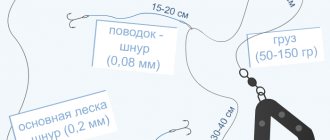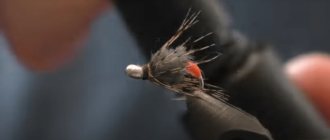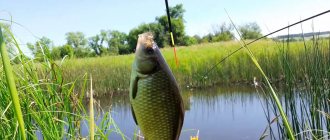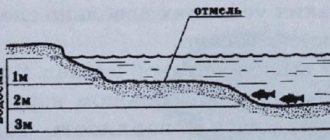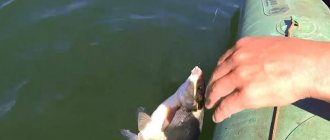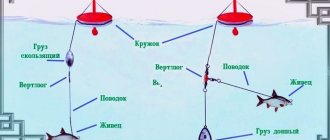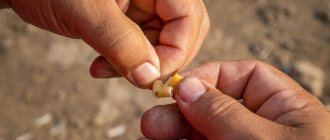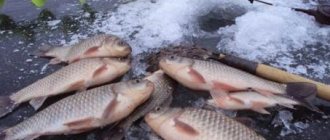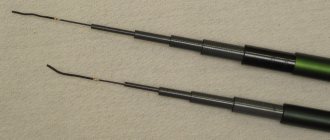Preparing bread for fishing
Bread
Bread as bait is most often used when fishing for fish from the carp family. This attachment seems very simple, but there are still a couple of nuances in its preparation. The main task is to ensure that the bread bait stays firmly on the hook and creates maximum attractiveness for the fish. Below we will tell you about several ways to achieve this:
- First way.
Mix vegetable oil with bread crumb and knead the resulting mixture with ordinary pharmacy cotton wool. This attachment will hold perfectly on a fishing hook. - Second way.
Stir the bread in hemp, cottonseed or linseed oil, and then lower it into boiling water for half a minute. As a result, a viscous mass is formed, exuding an aroma that is very attractive to underwater inhabitants. - Third way.
Fishing bread can be moistened with plain water and then squeezed out with a small cloth. The result should be a mixture of high consistency. Before putting the bait on the hook, you need to roll small balls out of it (the tip of the hook should not be visible). - Fourth way.
Wheat bread should be moistened with water, squeezed in gauze and crumbled onto a plate. Boiled potatoes (without peel) are also placed there. Proportions - 1:1. The ingredients are mixed until a homogeneous mass is obtained, to which vegetable oil is then added. The result is milky white balls.
Bread for fishing
can be mixed with flavorings - vanillin or special vegetable oils. Then the fish will react to the bait more actively.
Bread "sandwiches"
For more successful and productive fishing, you can use “sandwiches”, which use bread with other ingredients.
- Bread with giblets
. Rinse cow or sheep entrails well and boil. Then grind through a meat grinder along with a crust of black bread. Roll the resulting mass into balls and freeze. The balls need to be placed in the holes a couple of days before fishing. It is best that the bottom in the fishing area is clean - clay or sandy. Pieces of boiled intestines are suitable as bait. This bait is ideal for catching bream, roach and, in particular, perch. - Bread and potatoes
. A small piece of white bread crumb and well-cooked potatoes are combined in a ratio of 5 to 1. It is necessary to mix until a homogeneous dense dough is obtained. Then add a little margarine or fat so that the dough acquires the necessary viscosity. This will also help prevent the dough from drying out or becoming soggy when exposed to water. You can also add a pinch of honey, sugar, saffron, and soft cheese to the resulting dough. Fishermen say that this potato-bread dough is an excellent bait for carp fish, and of course the carp itself. - Bread and honey
. For this attachment option, it is best to take a loaf. Mix the loaf pulp with honey in a ratio of 10 to 1 and knead thoroughly to obtain a homogeneous mass. The resulting bait attracts carp fish, and roach and crucian carp are especially fond of it. Honey perfectly binds the mashed loaf, it becomes sweet and aromatic, which attracts fish. - Bread with blood
. Soak a piece of white bread with the crust cut off in fresh animal blood. To make the attachment sufficiently viscous, you need to mix the crumb soaked in blood with coarse wheat flour or clean, fresh bread. The bread not only becomes reddish in color, but also acquires an aroma that is attractive to fish. This bait attracts not only carp, but also attracts perch, by the way, regardless of the time of year.
How to make bread bait
A very small piece of any bread (crumb, crust, or a combination of these components) placed on a hook using the pinching method can often give good results. You don't want to press the bait too hard against the hook, as it's better to have small pieces flake off to entice the fish.
Find out also how to stew crucian carp in a frying pan and in a slow cooker.
This is the classic way to prepare the right bread bait for fishing. When the bread bait is saturated with water, it will swell and, accordingly, become soft enough for absorption by hungry fish. Often fishermen season bread with additional flavor and odor enhancers. A homemade bait mixture rarely contains more than three components. They include: base, flavor and feed.
Let's look at each of them:
- Bread, buns, and vanilla gingerbread serve as the perfect base;
- attractants (bran, cake, crackers, garlic, jam, aromatic oil - flaxseed, olive, sunflower) - lure crucian carp to the fishing spot due to its pronounced aroma;
- feed part (porridge, mixed feed) - makes the fish stay in the fishing spot.
Pay attention to the information about methods and recipes for preparing pearl barley for crucian carp fishing.
Often, fishermen add dyes to give the mixture a color attractive to crucian carp. They also use various flavoring additives and weighting agents that increase the weight of the bait and allow it to sink to the bottom more quickly. Dried bread is often used for bait. To soften it, add a little water (you can even from a pond) or vegetable oil.
Then they make balls based on the size of the hook and place them on it. This manipulation can be done directly while fishing. If the bait is prepared in advance, then at home you can add a chicken egg and any aromatic oil to the bread crumb, mix everything, roll into balls and wrap them in a napkin.
Here you can read about how to prepare pearl barley for fishing in a thermos.
For spring fishing, use the following bait:
- white bread crumb - 2 parts;
- milk powder - ½ part;
- crushed sunflower seeds - ½ part;
- feed, fish or poultry - 1 part;
- pea or corn flour - ½ part (for rolling the pellets).
Roll all ingredients into balls except the last one. Then you need to generously roll the pellets in pea or corn flour. When they fall into the water, during their descent to the bottom, thanks to deboning, the balls will begin to “dust,” attracting and attracting fish to the bait.
You need to follow a certain sequence when preparing the mixture for bait. The components of the bait are not uniform in either structure or moisture. If you are preparing a dry mixture for bait that does not require any heat treatment, it is best to simply mix all the ingredients and finish cooking near the pond.
Important! To moisten the mixture, you can add water from the pond, and you can also mix in soil to increase its weight.
“Dry” bait for catching crucian carp is prepared from:
- bread crumbs or dry bread - 200 g;
- ground sunflower seeds - 200 g;
- fried and ground Hercules flakes - 200 g;
- cookies - 300 g;
- a small lump of clay;
- two drops of anise tincture.
In the evening, fry the flakes and grind them together with the seeds. Add breadcrumbs or dry bread (ground in a blender) to them. Then pour the prepared ingredients into the bag. Already near the pond, you should complete the preparation by adding water and flavoring. Roll into pellets.
A third of the finished balls should be immediately thrown into the water, and the remaining ones should be placed on a hook. The two most popular components for crucian carp bait, which are traditionally used by fishermen, are corn and bread.
You may be interested in information on how to prepare wheat for crucian carp fishing.
To prepare bait you should use:
- 7–10 slices of bread or 2–3 buns;
- 1 can sweet corn.
In a bowl, mix all ingredients without draining. You should get a thick consistency, similar to a paste (if necessary, add bread as needed). If you have vanilla gingerbread, you can add those too. Leave the mixture for 10–15 minutes so that all the ingredients become friends. After this, form balls.
Corn and bread has been a proven bait among anglers for many years. Also, the aromatic corn liquid will attract crucian carp. This is perhaps one of the best homemade bait recipes for beginner anglers that is easy to prepare.
Fishing with bread
Fishing with bread
Usually they catch with bread on large rivers where there is a strong current; fish such as roach like to stay in a seething stream and therefore become a frequent trophy of floaters. The bread holds well in the current, precisely on the surface, and from the surface it is always eaten by roach or the ubiquitous bleak, which does not mind eating the crumb, despite the fact that the bread for bleak is still a large attachment, this small fish does not pay any attention to the size bait. I bite her motto, but I’ll take mine: so that the bread is in the middle layers of the water, the fisherman is required to competently load all the gear, namely, the loads must be in a certain order. In such a situation, an ordinary olive, made in a sliding version, can help.
It is good to fish with bread even in places with standing water. All ponds and lakes are excellent for this and are a large testing ground. The fisherman only needs to know how to correctly present the bait to the fish, and the rest depends on the fish itself, if it likes the bait, wait for a bite, if not, then there is no trial.
It is impossible to guess the mood of a fish. Therefore, on every fishing trip, we fishermen have to experiment and discover something new. Remember that everything is in your hands. The ability to properly present bait comes with age.
Conclusion. So, from the above, we should have understood that bread is a universal bait that catches white fish well. Store the bread in a suitable place. When fishing, you can keep the bread in a slightly damp cloth. With this storage, the nozzle will remain in good condition for a long time. Do not disdain different types of bread. Each crumb has its own qualities, for which it has gained popularity for a long time.
Fishing for bread has been developing for a very long time and has reached our time, and we modern fishermen are slowly modernizing it and introducing something new. Do not make simple pellets; the fish may like a flattened bait. Be sure to use cotton wool as a binding material, it will help the bread stay on the hook for a long time.
That's all I would like to say about fishing with bread, but remember bread is not a consumable material, but a noun, bread must be treated with respect, because bread is the head of everything.
How to put bread on a hook
When fishing for crucian carp, the method of setting the bait plays a rather important role. When performing this procedure, you need to proceed from the consistency of the bait and fishing conditions.
To attach unmoistened crumb, the hook must be immersed with the back side into the bait, and then lightly squeeze the nozzle with the index and thumb. When this procedure is performed correctly, the sting should be inside the bait.
When fishing for bread crumbs, it is better to use hooks equipped with a small wire spiral. In this case, the nozzle will hold much more securely and will not fly off during casting.
If you plan to fish with doughy bait in still water, the angler will need:
- form a ball with a diameter of 0.5–1 cm from the plastic mass;
- place the ball through the sting onto the bend of the hook;
- Flatten the bait a little on the sides.
When installed correctly, the tip should slightly “peek out” outward. For dough-like baits, hooks made of thick wire are used - this helps to hold the bait more securely.
When fishing with bread dough in moderate to strong currents, the bait should completely cover the hook. On the river, a bait shaped like a pacifier works better.
To properly install the bread crust, you need to insert the hook from the hard side and pull it out from the soft side. After performing this procedure, it is necessary to ensure that the tip remains open. If an angler knows how to bait a crucian carp, almost every bite will result in a fish being caught.
Hooking
From a small piece of bread crumb dough, make a ball in accordance with the size of the mouth of the intended fish and prick it onto the hook tip. Then they are formed on the understring or on the fore-end or completely on the hook in the form of a pea or pear.
Just like bread crumb, bread crust is a good bait for catching peaceful fish. You can fish with a bread crust on top and from the bottom. The bread crust is separated from a loaf of white bread. It is cut into cubes or oblong plates. Then fried in sunflower, hemp or corn oil.
Bread punch
Bread punch
What is Bread punch? In Russian it is “bread cutting”. It sounds incomprehensible, but in fact everything is simple: fishing is carried out using granules squeezed out of a bread slice with a special tool - a die cutter.
These tools are usually sold in sets, which contain die-cuts with tips of different sizes, producing grain granules of different diameters for catching different fish.
Previously, such a tool could not be found in our stores, but now in some places die-cuts have begun to be found on sale, primarily in carp departments.
So how does this tool work? Take a slice of bread, place it on a hard, flat surface and stick a die cutter into it. It turns out that the depression in it is filled with bread, and due to the fact that the thickness of the slice is greater than the depth of the cutting, the granule turns out to be compressed and, therefore, then it holds more securely on the hook.
Next, the die-cut filled with bread is taken in one hand, and the hook is inserted into the bread with the other hand, and the sting should go from top to bottom, and the shank of the hook should be parallel to the die-cut. The tip of the hook pierces the bread and falls into the slot. Next, you need to turn the hook and use it to pull the bread granule out of the die-cut. Now, if you cast, the most interesting thing will happen - the bread swells and increases in size in water, the bait becomes soft, fluffy, and at the same time it holds perfectly on the hook.
Making catchable bait from bread
There are several secret recipes for preparing catchable bait from bread for fishing.
Bread crust is an excellent bait for catching trophy white fish from the surface and bottom. You will need a loaf of white bread. We separate the crumb from the loaf (it can be used for bait), cut the crust into small cubes and fry in sunflower oil (preferably homemade, so that the bread is aromatic and pleasant to the taste), you can also use corn or hemp oil. It must be said that when baiting, you need to pierce the bread crust and remove the sting through the crumb - this way the crust stays on the hook better and does not fly off when casting. Bread crusts should be stored in an airtight container to prevent them from drying out. Baby food jars are perfect for this. Bread crumb is the most common attachment, familiar to us since childhood. To prepare the crumb, use fresh rye or wheat bread or a loaf for sandwiches.
Bread bait
Many people use bread as bait when catching white fish. But bread is rarely used as bait.
Toast bread works well for this application, but requires preparation. First you need to trim the crusts with a knife, then the pieces of bread are soaked and the water is squeezed out. The resulting bread mass is thrown into small balls. The disadvantage of this type of feeding is that large pieces of bread often remain in the mixture, with which the fish quickly gorge themselves.
If you prefer a finer ground mass and want to completely get rid of large pieces in your bait, you can make “liquid bread” for feeding. To do this, remove the crusts from the toast bread slices, then cut the slices into small pieces, grind in a mixer and seal tightly in a plastic bag. The bread particles contain enough moisture that they can be pressed into dense balls, but at the bottom they quickly disintegrate, forming a cloud. Feeding with their help is justified primarily when fishing for chub and roach.
To catch chub at temperatures around zero, a medium piece of white bread is enough for fishing the entire afternoon. In the summer, on a reservoir where large roaches live, you will need about four pieces of bread diluted in water for fishing for five hours.
“Liquid bread” can not only be thrown by hand, but also filled into a feeder. This bait is used not only for catching freshwater fish, but also mullet and sea bream. When sea fishing, it makes sense to mix bread with one or two cans of sardines or anchovies to enhance the attractiveness of the bait.
What is the best bread to use?
Thanks to its bright white color, wheat bread is clearly visible to the carp representative, and bait made from it can really bring a decent catch on lakes with a muddy bottom. Especially when the crucian carp start feeding and muddying the water, they will still be able to detect the bait.
Did you know? Fish do not add new scales as they grow, they simply increase in size. Thus, growth rings are formed, which show the age of the aquatic inhabitant.
The fish also reacts well to pellets made from vanilla, rye (black) or grain bread, but in reservoirs where the bottom is very silted, a representative of cyprinids may not notice such bait. The fact is that crucian carp in different reservoirs and at certain times of the year prefer different types of bait and different flavors. Anglers are always trying new baits or returning to proven ones.
What flavorings are best to use?
Bread, as a fishing bait, does not always have enough of its own smell to attract crucian carp. Therefore, various flavorings are actively used. The easiest way to add a pleasant aroma to bread balls is to pour 1 tbsp onto half a kilogram of crumb. a spoonful of unrefined sunflower oil.
Other popular bread flavor enhancers include:
- valerian tincture;
- garlic juice;
- cake;
- milk, kefir, yogurt, etc.;
- vanilla;
- cinnamon;
- juice from canned corn;
- specialized liquid flavors (anise, tutti-frutti, etc.).
You can prepare bread crumbs for fishing in advance or directly on the shore. In any case, the procedure is performed according to the same scheme. The crumb rolls around in your hands. Gradually water and flavoring are added to it. Most anglers make a ball of bread the size of a tennis ball. Then small pieces are plucked off from it, which are again given a rounded shape, and then placed on a hook.
You can use cinnamon and vanilla powder as a flavoring for bait with bread.
Fishing for bread and bread crumbs
The advantage of bread crumb is that this attachment is generally available, and the balls from it stick very well on the hook. True, it is rarely used in its pure form: fish sometimes treat this bait quite coolly, preferring various cereals, peas, and corn grains. However, the bite on bread can be significantly improved if you use suitable additives.
Adding Unifeed
Adding ordinary fishing food to the bread crumb enhances its attractiveness. The bait itself, however, does not hold well on the hook, becoming looser, so it is better to give the crumb the shape of a drop. For this combination they take crucian carp, carp, ide, chub, large roach, bream, silver bream, dace and other white fish.
Bread crust for bream
But it’s better to catch bream not with crumbs, but with a piece of crusty bread. Before fishing, pieces of bread are fried in a frying pan, and then square pieces are cut out of them so that the crumb is adjacent to the crust. It allows the bait to stay on the hook more firmly, and its decent size (1x1x1 cm) prevents small things from knocking the bait down, although there will certainly be attempts to do so.
Carp and carp can easily be used for bread crust. In this case, an even larger piece (with a side of about 1.5 cm) is hung on a hook than when fishing for bream.
"A cheese sandwich
To catch chub, you can mix bread crumb and grated cheese (Kostroma, cheddar, Edam) in equal proportions. The best method of fishing with such a bait is a running donka.
Bread with garlic for crucian carp
Adding a very small amount of garlic to the bread crumb (literally at your fingertips) will attract crucian carp to your baits. And if you add a “garlic” additive to your bait or bait, then it is quite possible to interest all the crucian carp living in the pond.
For those with a sweet tooth
Mixing crumbs from honey gingerbread or “black” gingerbread into the crumb increases the likelihood of bites from crucian carp, as well as carp and carp. These fish have a “sweet tooth” and are partial to honey. However, try not to abuse its quantity. A bait that is too sweet will scare rather than attract fish.
Store-bought flavors
To enhance the bite, you can mix various flavors into the bread: vanilla, dill, strawberry, banana and others, which are offered to fans by fishing stores. Before use, carefully read the instructions: how much aromatic mixture should be added, what time of year it works, what fish it is intended for.
When using fragrances, remember that they only work well for one day. If you plan to fish for several days, then the bait must be prepared every day.
Vegetable oils
Garlic, hemp, flaxseed, unrefined sunflower, and, of course, anise oils added to bread crumb have been used by fishermen since ancient times. Since then, little has changed: just like in the old days, adding a small amount of these oils to bread provokes fish to bite more actively.
With porridge
An excellent attachment is obtained by mixing bread crumb with millet or oatmeal porridge in a 1:1 ratio. The crumb makes the bait more viscous, and it stays on the hook better. Millet is one of the most attractive baits for carp, crucian carp and bream. A mixture of bread and oatmeal porridge will attract carp to the bait. However, the bream can ignore this bait.
Crust or crumb?
They also catch fish such as chub and ide on bread. Moreover, fishermen often argue about how best to catch these fish: with a crust of bread on top or with crumbs in the water column. In my experience, both methods are effective. Only you need to use them at different times of the year. In spring and autumn it is still better to fish at the bottom, and the bite on top is more likely in the summer.
Bread with potatoes
A bait consisting of equal parts of rye bread and mashed potatoes is practically a win-win when fishing for carp and carp. Especially if you flavor it a little with unrefined sunflower oil.
With animal bait
Bread crumb is used, as well as dough when fishing with “sandwiches”. The dough in combination with maggots, bloodworms or a piece of worm evokes the appetite of the same white fish.
True, you need to make “sandwiches” in different ways. In the “maggot-crumb” combination, the maggot is placed on the hook first, and the tip of the hook is covered with bread.
If you are fishing with the “crumb-bloodworm” or “crumb-worm” combination, first hang bread on the hook, and then cover the tip with animal bait.
Some fishermen, for example, do not bother with baiting two different baits, but simply mix crumpled fish into the bread.
How to catch someone
So, the bait is ready. Now the fun part begins - fishing for bread. The bread bait is made according to the order listed in the previous chapter. Dividing according to the depth to which the cast will be made:
- The surface is high melting.
- At medium depths there are roaches and bream.
- Along the bottom - crucian carp, bream, carp.
The verkhovka (verkhoplavka, serka) walks along the surface itself. To catch it, a fishing line with a thickness of 0.15-0.20, a small hook of 3-3.5 in size and a light float balanced by a corresponding weight are placed on a fishing rod.
Bait
Pieces are plucked from the slightly moistened bread crumb and rolled into balls the size of a match head. They are put on the hook, slightly covering the sting. Now the question is how to catch it. The hook is released to a depth of 10-15 centimeters. Just pour dry crumbs into the water and start the fun. The serka bites sharply. The peculiarity is that the little fish play a lot with the bait and the float dances on the water like crazy. The main thing here is to catch the moment when it suddenly goes under the water and hook it.
Now more serious prey - white bream, rudd, roach. In this case, catching fish with bread is a little more difficult. These fish stay at “half water,” as fishermen say. This means that you need to set the depth at which the bait will be located approximately halfway between the surface and the bottom. The hook goes 3-4. Medium float. Maybe a pen. Feed with a preparation that you prepared for fishing with your own hands.
Bread bait again
There are slight differences here. The same crumb comes with different flavors. For example, bread with garlic, with anise, with vanilla. No more ingredients. The pellets are made the size of a small pea. A little elongated. These breeds do not bite very quickly. Usually the float moves to the side, slowly sinking. Hook when completely submerged.
Heavyweights on the crust
Well, the most serious bottom specimens.
Crucian carp, carp, bream. They make a special bait from bread. The crumb and crust are moistened and kneaded into plasticine or dough. Cake is added to it, kneading thoroughly, and a couple of drops of anise or barberry. It's good to add a little flour. The ball should be elastic, but it should not instantly crumble in the water. Use bean-sized pellets. These fish need to be caught from the bottom. That is, a hook baited with bread lies freely on the bottom, as does the load of gear. The goose feather float stands with a slight inclination. Line on the base 0.45. On a leash from 0.3 to 0.4. Hook starting from 5.
For carp and carp, respectively, a thicker fishing line is used. And a hook ranging from 7.5 to 10, and a more powerful float.
bait balls are thrown. One per fishing rod.
